 I am very pleased to announce that Dr. Tao Jiang, CICATS Investigator Advocate and Assistant Professor of Medicine, has been appointed to the faculty of the Institute for Regenerative Engineering. Dr. Jiang received a B.S. in Chemical Engineering in 1999 and an M.S. in Materials Science in 2001, both from Tsinghua University in Beijing.
I am very pleased to announce that Dr. Tao Jiang, CICATS Investigator Advocate and Assistant Professor of Medicine, has been appointed to the faculty of the Institute for Regenerative Engineering. Dr. Jiang received a B.S. in Chemical Engineering in 1999 and an M.S. in Materials Science in 2001, both from Tsinghua University in Beijing.
He then went on to pursue his doctoral degree and received a Ph.D. in chemical engineering from the University of Virginia, Charlottesville, VA. His doctoral research, under my supervision, focused on the design, development, and evaluation of novel hybrid scaffolds from natural polymer chitosan and synthetic polymer PLGA for bone-tissue engineering.
Dr. Jiang joined Zimmer, Inc., one of the world’s leading medical device companies, as a senior research scientist immediately after obtaining his Ph.D. At Zimmer, he played a variety of leading roles in evaluating and exploring cutting-edge technologies for the regeneration of musculoskeletal tissues including bone, cartilage, ligament, and tendon. In addition, he played a key role in developing Chondrofix Allograft for cartilage repair. Fully launched in the U.S. in 2011, it was the first Zimmer biological product developed in-house.
Dr. Jiang has over 20 peer-reviewed publications in journals such as Biomaterials, Journal of Biomedical Materials Research, Acta Biomaterialia, and PNAS, as well as many conference presentations. He has six issued/pending patents and invention disclosures.
At the University of Virginia, Dr. Jiang was awarded the 2008 Faculty Award for Excellence in Doctoral Studies. At Zimmer, he received a Zimmer Publication Award from the chief scientific officer and a Zimmer Impact Award from the company.
Dr. Jiang serves as a peer reviewer for a number of high-impact scientific journals including Biomaterials, Carbohydrate Polymers, and Materials Science and Engineering.
Dr. Jiang’s research interests include advanced biomaterials, drug delivery, tissue engineering, and therapies for musculoskeletal diseases.
Speaking for all of the Institute faculty, we are excited to have him join us, and we look forward to working with our newest faculty colleague.
 It was my honor and privilege to serve as Visiting Professor in the Department of Chemical Engineering at the University of Texas, Austin. During the visit, I delivered the Pirkey lectureship entitled “Musculoskeletal Regenerative Engineering: Taking on the Grand Challenges.” My talk highlighted the tremendous work being carried out here at the Institute for Regenerative Engineering. More specifically, I discussed the unprecedented strides predicted for the next decade in regenerating musculoskeletal tissues, a move from an era of advanced prosthetics to what we terms “Regenerative Engineering.”
It was my honor and privilege to serve as Visiting Professor in the Department of Chemical Engineering at the University of Texas, Austin. During the visit, I delivered the Pirkey lectureship entitled “Musculoskeletal Regenerative Engineering: Taking on the Grand Challenges.” My talk highlighted the tremendous work being carried out here at the Institute for Regenerative Engineering. More specifically, I discussed the unprecedented strides predicted for the next decade in regenerating musculoskeletal tissues, a move from an era of advanced prosthetics to what we terms “Regenerative Engineering.” I am very pleased to announce that Dr. Tao Jiang, CICATS Investigator Advocate and Assistant Professor of Medicine, has been appointed to the faculty of the Institute for Regenerative Engineering. Dr. Jiang received a B.S. in Chemical Engineering in 1999 and an M.S. in Materials Science in 2001, both from Tsinghua University in Beijing.
I am very pleased to announce that Dr. Tao Jiang, CICATS Investigator Advocate and Assistant Professor of Medicine, has been appointed to the faculty of the Institute for Regenerative Engineering. Dr. Jiang received a B.S. in Chemical Engineering in 1999 and an M.S. in Materials Science in 2001, both from Tsinghua University in Beijing.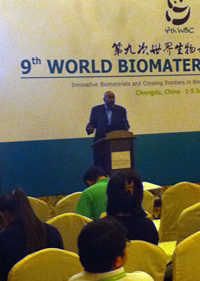 In early June, I was honored to give a keynote address at the World Biomaterials Congress in Chengdu, China. During my talk, “Hierarchical Nanostructures for Tissue Regeneration,” I highlighted the elegant work done by the Institute for Regenerative Engineering, including my students and fellows. The symposium, Hierarchical 3-Dimensional Structures for Tissue Regeneration, was chaired by my former graduate student, Professor Justin Brown from the Department of Bioengineering, Pennsylvania State University. In addition, Dr. Lakshmi Nair, Dr. Sangamesh Kumbar and Dr. Meng Deng, also from the Institute, gave talks during the symposium. This was my first visit to Chengdu, I was deeply impressed by its natural beauty, as well as its historical and culture treasures. I so appreciated the hospitality provided by the planners. I also want to thank Professor Xingdong Zhang, chairman of the 9th WBC organizing committee, for arranging a wonderful conference.
In early June, I was honored to give a keynote address at the World Biomaterials Congress in Chengdu, China. During my talk, “Hierarchical Nanostructures for Tissue Regeneration,” I highlighted the elegant work done by the Institute for Regenerative Engineering, including my students and fellows. The symposium, Hierarchical 3-Dimensional Structures for Tissue Regeneration, was chaired by my former graduate student, Professor Justin Brown from the Department of Bioengineering, Pennsylvania State University. In addition, Dr. Lakshmi Nair, Dr. Sangamesh Kumbar and Dr. Meng Deng, also from the Institute, gave talks during the symposium. This was my first visit to Chengdu, I was deeply impressed by its natural beauty, as well as its historical and culture treasures. I so appreciated the hospitality provided by the planners. I also want to thank Professor Xingdong Zhang, chairman of the 9th WBC organizing committee, for arranging a wonderful conference.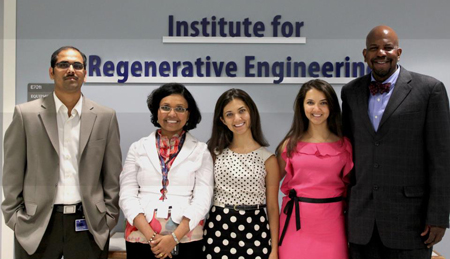
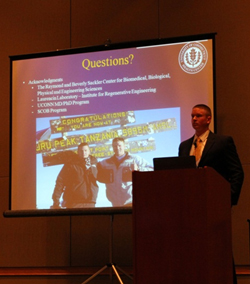 This past weekend, Shaun McLaughlin, an M.D./Ph.D. student at the Institute for Regenerative Engineering working under my supervision attended the national M.D./Ph.D. student conference in Keystone, Colorado. Each year, the University of Colorado Medical Scientist Training Program sponsors and coordinates this event. The conference provides an opportunity for M.D./Ph.D. students around the country to present their work and interact with other students and prominent scientific investigators. This meeting has taken place since 1986 and currently over 225 students, faculty, and alumni from over 60 academic institutions in the United States and Canada attends annually.
This past weekend, Shaun McLaughlin, an M.D./Ph.D. student at the Institute for Regenerative Engineering working under my supervision attended the national M.D./Ph.D. student conference in Keystone, Colorado. Each year, the University of Colorado Medical Scientist Training Program sponsors and coordinates this event. The conference provides an opportunity for M.D./Ph.D. students around the country to present their work and interact with other students and prominent scientific investigators. This meeting has taken place since 1986 and currently over 225 students, faculty, and alumni from over 60 academic institutions in the United States and Canada attends annually.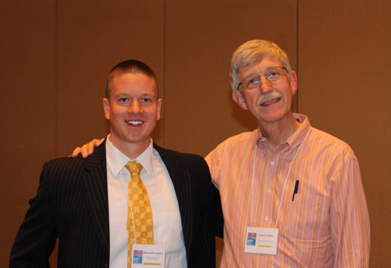

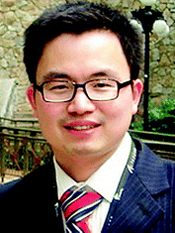 Dr. Meng Deng received a B.S. in Chemical Engineering in 2004 from the very prestigious Tsinghua University in Beijing and his Ph.D. in Chemical Engineering in 2010 from the University of Virginia, Charlottesville, VA. He completed his doctoral thesis in biomaterials and tissue engineering under my mentorship at the University of Virginia. His Ph.D. project was focused on the design and development of novel biomaterials and matrices for bone regeneration based on a highly versatile platform of biocompatible polyphosphazene blends. He also worked on developing mechanically competent bioresorbable nanostructured three-dimensional biomimetic scaffolds for accelerated bone healing. Meng was an extraordinary Ph.D. Student and received He was the recipient of the Special Recognition Award for Academic Achievement from the Department of Chemical Engineering, and the Outstanding Doctoral Dissertation Award for the Department of Chemical Engineering from the University of Virginia. In 2008, the People’s Republic China awarded Dr. Deng the China Government Award for Outstanding Students Abroad. After completing his Ph.D. in 2010 he has been a Postdoctoral Fellow working on regenerative engineering of complex musculoskeletal tissues using integrated graft systems under my guidance in the Institute for Regenerative Engineering at the University of Connecticut Health Center. His research interests include biomaterials, drug delivery, nanotechnology, and regenerative engineering.
Dr. Meng Deng received a B.S. in Chemical Engineering in 2004 from the very prestigious Tsinghua University in Beijing and his Ph.D. in Chemical Engineering in 2010 from the University of Virginia, Charlottesville, VA. He completed his doctoral thesis in biomaterials and tissue engineering under my mentorship at the University of Virginia. His Ph.D. project was focused on the design and development of novel biomaterials and matrices for bone regeneration based on a highly versatile platform of biocompatible polyphosphazene blends. He also worked on developing mechanically competent bioresorbable nanostructured three-dimensional biomimetic scaffolds for accelerated bone healing. Meng was an extraordinary Ph.D. Student and received He was the recipient of the Special Recognition Award for Academic Achievement from the Department of Chemical Engineering, and the Outstanding Doctoral Dissertation Award for the Department of Chemical Engineering from the University of Virginia. In 2008, the People’s Republic China awarded Dr. Deng the China Government Award for Outstanding Students Abroad. After completing his Ph.D. in 2010 he has been a Postdoctoral Fellow working on regenerative engineering of complex musculoskeletal tissues using integrated graft systems under my guidance in the Institute for Regenerative Engineering at the University of Connecticut Health Center. His research interests include biomaterials, drug delivery, nanotechnology, and regenerative engineering. Dr. Deng is an outstanding researcher in the institute. He has published more than 20 research articles in high impact journals like Biomaterials, Advanced Functional Materials, and the Proceedings of the National Academy of Sciences. His research work has been highlighted on journal covers several times. He was also recognized for his research work. For instance, in 2010, he received STAR award from the Society for Biomaterials in Seattle, WA. Last month, he won a Young Scientist Award from the World Biomaterials Congress 2012 and traveled to Chengdu China to receive this great honor. As a mentor for Dr. Deng, I am so proud when I see he is being recognized for his great achievements.
Dr. Deng is an outstanding researcher in the institute. He has published more than 20 research articles in high impact journals like Biomaterials, Advanced Functional Materials, and the Proceedings of the National Academy of Sciences. His research work has been highlighted on journal covers several times. He was also recognized for his research work. For instance, in 2010, he received STAR award from the Society for Biomaterials in Seattle, WA. Last month, he won a Young Scientist Award from the World Biomaterials Congress 2012 and traveled to Chengdu China to receive this great honor. As a mentor for Dr. Deng, I am so proud when I see he is being recognized for his great achievements.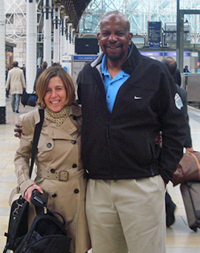 Last month, I had the honor to be asked to travel to London as part of an international review panel for the Wellcome Trust. The Trust is a worldwide charitable organization dedicated to achieving extraordinary improvements in human and animal health. It was great to be able to see the extraordinary research being performed by scientists in the UK.
Last month, I had the honor to be asked to travel to London as part of an international review panel for the Wellcome Trust. The Trust is a worldwide charitable organization dedicated to achieving extraordinary improvements in human and animal health. It was great to be able to see the extraordinary research being performed by scientists in the UK.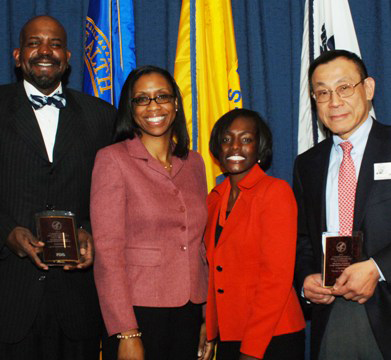 As many of you know, one of my missions is to help reduce or even eliminate the health disparities of underserved populations in the United States. Health disparities represent a major public health emergency in our country and eliminating them is a major challenge.
As many of you know, one of my missions is to help reduce or even eliminate the health disparities of underserved populations in the United States. Health disparities represent a major public health emergency in our country and eliminating them is a major challenge.